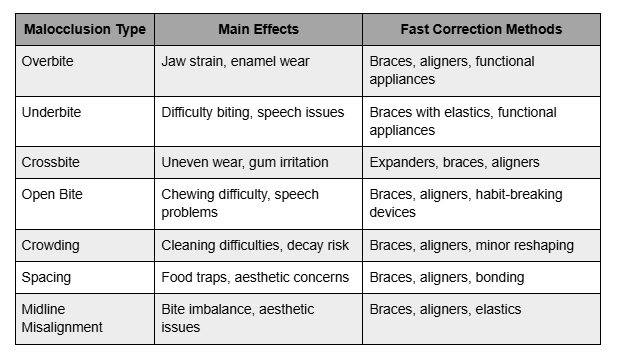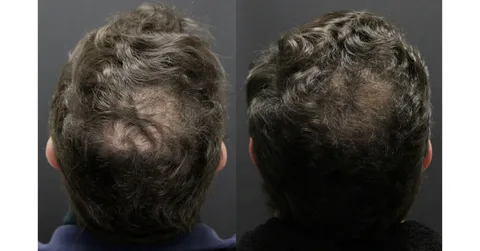7 Malocclusion Types an Orthodontist Can Correct Fast

A healthy, aligned smile is more than just an aesthetic goal, it plays a vital role in oral health and overall wellbeing. Malocclusion, or misalignment of the teeth and bite, can impact chewing, speech, and even jaw function. Fortunately, modern orthodontics offers effective and timely solutions for a variety of malocclusion types. Understanding the different forms of misalignment and the corrective measures available helps patients appreciate the importance of seeking professional care. With early intervention and expert treatment, many orthodontic issues can be resolved efficiently, restoring both function and confidence.
What Is Malocclusion?
Malocclusion occurs when teeth are not properly aligned within the jaw or when the bite does not fit together correctly. While minor misalignments may be cosmetic, significant malocclusion can lead to discomfort, uneven tooth wear, jaw pain, and difficulties with oral hygiene. Malocclusion can develop due to a mix of genetic, developmental, and environmental factors, including:
-
Inherited jaw or tooth shapes
-
Early loss of baby teeth
-
Thumb-sucking or prolonged pacifier use
-
Tongue thrusting
-
Facial trauma or injury
Orthodontic intervention is often the most effective solution, guiding teeth and jaws into proper alignment. This ensures functional harmony, reduces the risk of oral health issues, and enhances overall appearance.
The Importance of Early Detection and Fast Correction
Addressing malocclusion promptly can prevent complications that affect oral and overall health. Quick correction reduces the risk of tooth decay caused by crowded or overlapping teeth, prevents excessive wear on certain teeth, and alleviates jaw discomfort or temporomandibular joint (TMJ) problems.
Furthermore, fast intervention can improve self-confidence by correcting misalignment before it significantly impacts speech or aesthetics. An orthodontist Kirkcaldy can assess each case and provide targeted treatment plans designed to correct misalignments efficiently while minimising discomfort.

7 Malocclusion Types That Can Be Corrected Quickly
Modern orthodontic techniques allow for relatively fast correction of many common malocclusion types. Understanding these forms helps patients recognise issues early and seek timely treatment.
1. Overbite (Deep Bite)
-
Description: The upper front teeth overlap the lower teeth significantly.
-
Effects: Excessive bite pressure can lead to enamel wear, jaw strain, and even speech difficulties.
-
Correction: Traditional braces, clear aligners, or functional appliances gradually reposition teeth to achieve proper alignment.
2. Underbite
-
Description: The lower teeth protrude beyond the upper teeth.
-
Effects: Can cause difficulty biting, speech challenges, and discomfort in the jaw.
-
Correction: Braces with elastics, functional appliances, or, in severe cases, orthognathic surgery. Early intervention speeds up treatment.
3. Crossbite
-
Description: One or more upper teeth bite inside the lower teeth when closing the mouth.
-
Effects: Uneven wear on teeth, gum irritation, and asymmetrical facial development.
-
Correction: Palatal expanders, braces, or aligners can quickly adjust tooth positioning and restore proper bite alignment.
4. Open Bite
-
Description: Front teeth do not meet when the mouth is closed.
-
Effects: Can interfere with biting and chewing, sometimes affecting speech.
-
Correction: Braces, clear aligners, or habit-breaking appliances (for thumb-sucking or tongue-thrust habits) help close the bite efficiently.
5. Crowding
-
Description: Teeth overlap due to insufficient space in the jaw.
-
Effects: Crowding makes cleaning difficult, increasing the risk of decay and gum disease.
-
Correction: Braces, clear aligners, or minor enamel reshaping create room for proper alignment. Early treatment accelerates results.
6. Spacing (Gaps Between Teeth)
-
Description: Excess space between teeth may result from missing teeth or jaw-tooth size discrepancies.
-
Effects: Food traps, aesthetic concerns, and potential bite issues.
-
Correction: Braces or aligners close gaps efficiently. Minor spacing can also be managed with bonding.
7. Midline Misalignment
-
Description: The centre of the upper teeth does not align with the lower teeth.
-
Effects: Aesthetic imbalance and uneven bite function.
-
Correction: Targeted braces or aligners, sometimes in combination with elastics, quickly shift teeth to the correct midline.
Optional Table for Readability:

How Orthodontists Achieve Fast Corrections
Speedy correction of malocclusion is possible with early diagnosis, customised treatment plans, and the use of modern appliances. Some key strategies include:
-
Clear Aligners: Provide gradual, predictable tooth movement and can reduce overall treatment time.
-
Self-Ligating Braces: Reduce friction, allowing teeth to move more efficiently.
-
Digital Planning and 3D Imaging: Enable precise bracket placement and treatment simulation, minimising adjustments.
These approaches, combined with regular monitoring, allow orthodontists to correct misalignments safely and effectively while keeping discomfort to a minimum.
When to Consult an Orthodontist or Emergency Dentist
Although most orthodontic issues progress gradually, some situations require immediate attention:
-
Broken brackets or wires that cause pain or irritation.
-
Sudden swelling, trauma, or injury to the teeth or jaws.
In such cases, contacting an emergency dentist in Kirkcaldy ensures quick management of the problem, preventing delays in treatment and avoiding complications. Timely intervention can protect both oral health and the efficiency of the orthodontic plan.

Patient Care Tips During Malocclusion Treatment
Maintaining proper oral hygiene and appliance care is crucial for fast and effective correction. Practical tips include:
-
Avoid hard, sticky, or chewy foods that may damage braces or aligners.
-
Brush and floss meticulously, particularly around brackets and wires.
-
Use orthodontic wax to cover any irritating areas.
-
Attend all scheduled adjustment appointments.
-
Contact your orthodontist if pain, swelling, or appliance damage occurs.
Following these guidelines helps patients maintain treatment momentum and achieve results efficiently.
Conclusion
Malocclusion can affect more than just appearance; it influences oral function, comfort, and long-term dental health. Fortunately, with modern orthodontic techniques, many types of misalignment can be corrected quickly and effectively. By understanding the common malocclusion types and seeking timely professional care, patients can enjoy a healthier, more confident smile.
For reliable orthodontic and dental support, trust the experts in Kirkcaldy to provide personalised, safe, and efficient treatment that restores both function and aesthetics.



